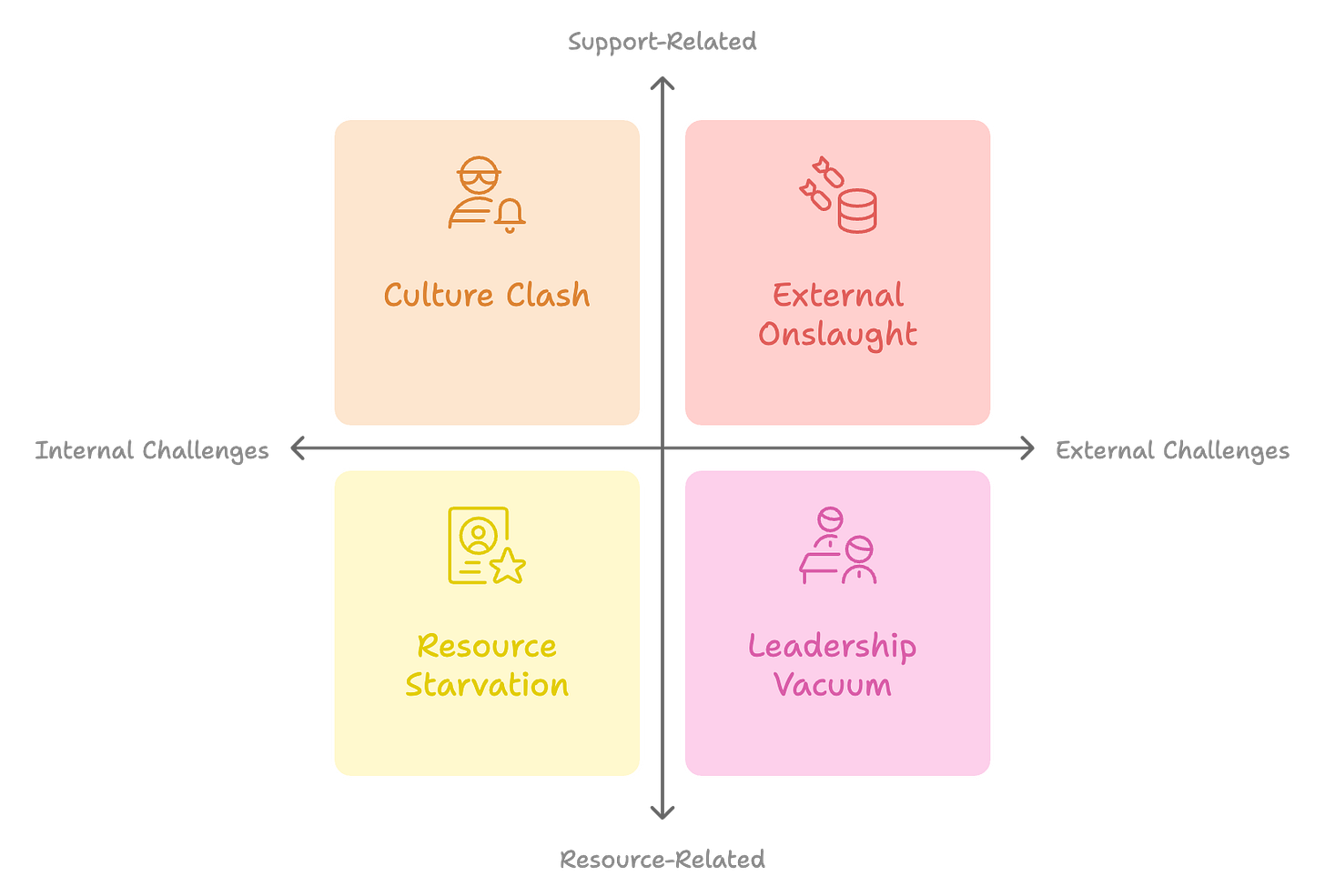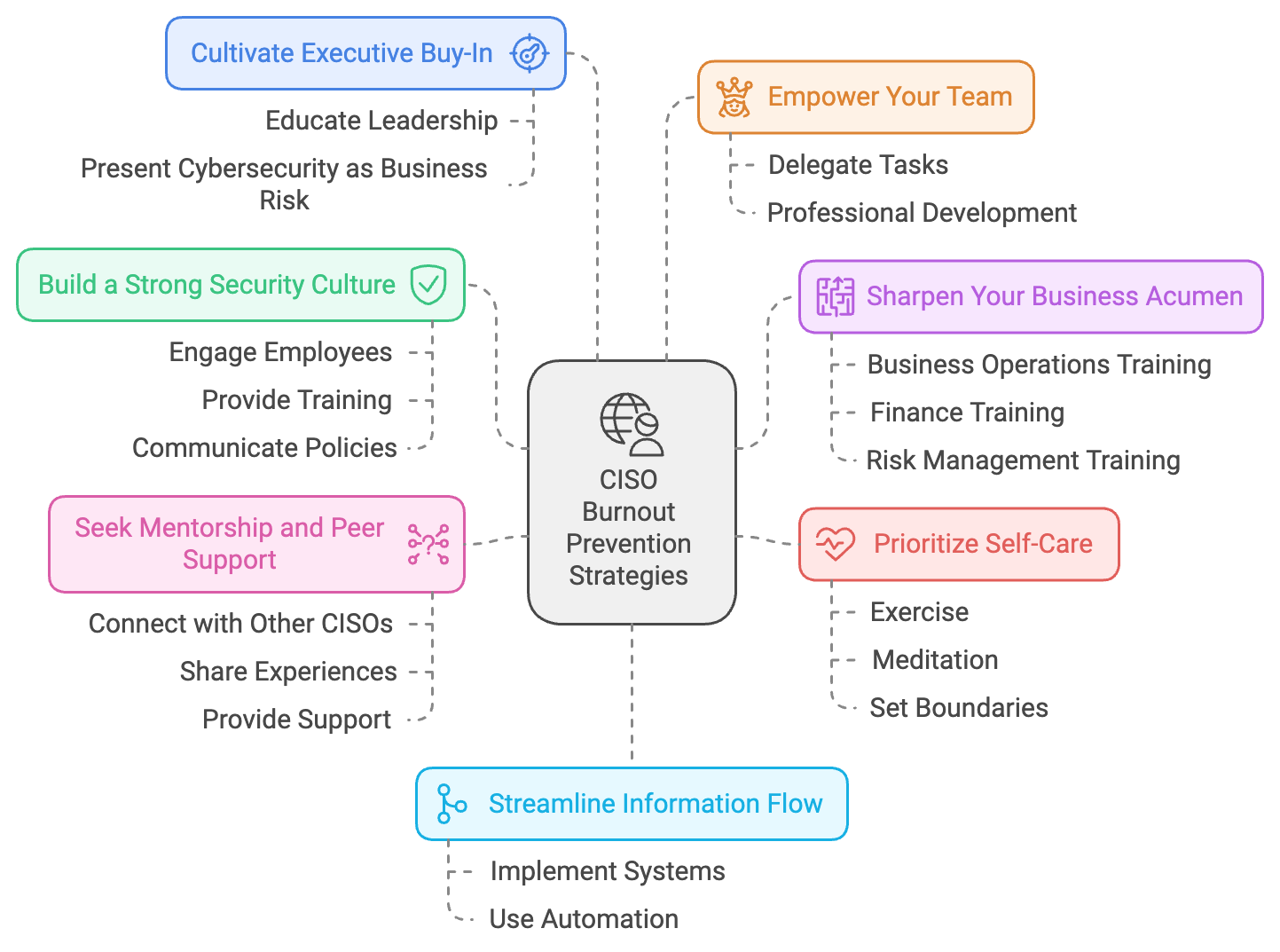The cybersecurity landscape is a battlefield. As the generals in this digital war, CISOs are under immense pressure, facing a barrage of threats and challenges. Burnout is an epidemic in the CISO community, with an average tenure of just over two years. But what's driving this exodus? And more importantly, what can CISOs do to not just survive, but thrive in this demanding role?
This blog post explores the six main sources of CISO burnout, outlines a CISO maturity model that offers a path to greater resilience, and provides tactical recommendations to combat this pervasive issue.
The Six Horsemen of CISO Burnout: A Deep Dive
While every CISO's journey is unique, research suggests that certain stressors are particularly potent in fueling burnout:
The Culture Clash: CISOs often struggle to navigate organizational cultures that undervalue cybersecurity. A lack of executive support and understanding can lead to feelings of isolation and powerlessness, hindering their ability to effectively manage risks.
The Resource Starvation: Limited budgets and inadequate staffing plague many CISOs. Competing with other departments for resources can feel like a constant battle, adding to their stress and frustration.
The Weight of the World: The ever-evolving threat landscape and the 24/7 nature of cybersecurity create a relentless sense of urgency. CISOs often find themselves working long hours, sacrificing personal time, and struggling to maintain a healthy work-life balance.
Lost in Translation: Bridging the gap between technical jargon and business language is a constant challenge for CISOs. Communicating complex security concepts to non-technical stakeholders, especially board members, can be frustrating and time-consuming.
The External Onslaught: Vendors, regulators, the media, and even cybercriminals themselves contribute to the pressure CISOs face. Persistent vendor outreach can distract from critical tasks, while media scrutiny and regulatory compliance demands add another layer of complexity.
The Leadership Vacuum: Insufficient executive support is a major driver of CISO burnout. When CISOs lack the authority, resources, and backing they need from leadership, their efforts can feel futile, leading to disillusionment and a desire to exit.
These stressors rarely exist in isolation. They interact and amplify each other, creating a perfect storm for burnout.
CISO Maturity Levels: A Roadmap from Isolation to Integration
As CISOs gain experience and develop their skills, they tend to progress through distinct maturity levels, each marked by a shift in perspective and approach:
CISO 1.0: The Technocrat: CISO 1.0s are deeply rooted in the technical aspects of cybersecurity. They excel at network monitoring, vulnerability scanning, and incident response, but may struggle with broader organizational awareness and business communication. This technical focus, coupled with a lack of business acumen, can lead to isolation and limit their influence within the organization.
CISO 2.0: The Risk Manager: CISO 2.0s begin to adopt a more strategic perspective, moving beyond technical tasks to focus on risk identification and mitigation. They align cybersecurity with business objectives and start to understand the language of risk management. However, communication challenges may persist, and they may not yet have the same level of influence as other C-suite executives.
CISO 3.0: The Business Enabler: CISO 3.0s represent the pinnacle of CISO maturity. They seamlessly integrate cybersecurity into the organization's strategic planning, using their insights to drive business goals while mitigating risks. They speak the language of the boardroom, advocating for cybersecurity investments and fostering a culture of security awareness. This level of integration and influence brings greater job satisfaction and reduces feelings of isolation, making them less susceptible to burnout.
While burnout can affect CISOs at all maturity levels, the way they cope with stress evolves significantly. CISO 1.0s and 2.0s often resort to emotion-based coping mechanisms, such as overworking, which can exacerbate burnout. In contrast, CISO 3.0s leverage problem-based coping, collaborating with their teams, aligning with organizational culture, and addressing the root causes of stress. This strategic approach allows them to manage their workload more effectively, feel more connected to the organization, and ultimately thrive in their role.
Tactical Recommendations: Fighting Burnout on the Front Lines
CISOs can implement several practical strategies to combat burnout and build resilience within their organizations:
Cultivate Executive Buy-In: Proactively engage with senior leadership to educate them about the CISO role and its importance. Present cybersecurity in terms of business risk and articulate how investments in security contribute to organizational goals.
Build a Strong Security Culture: Champion a security-aware culture by engaging employees at all levels. Provide regular security awareness training, communicate security policies clearly, and encourage a "security-first" mindset throughout the organization.
Empower Your Team: Delegate tasks effectively, providing clear responsibilities and decision-making authority. Create opportunities for professional development and growth within the security team.
Sharpen Your Business Acumen: Invest in training and development opportunities to enhance your understanding of business operations, finance, and risk management. Learn to communicate complex security concepts in clear, concise business language.
Streamline Information Flow: Implement systems and processes to manage information overload effectively. Use automation to reduce manual tasks and free up time for strategic initiatives.
Prioritize Self-Care: Make time for activities that promote physical and mental well-being, such as exercise, meditation, or spending time with loved ones. Establish boundaries to prevent work from encroaching on personal time.
Seek Mentorship and Peer Support: Connect with other CISOs and cybersecurity professionals to share experiences, best practices, and support. A strong network can provide valuable insights and guidance, helping you navigate challenges and reduce feelings of isolation.
By embracing these tactical recommendations, CISOs can equip themselves with the tools and support they need to combat burnout, thrive in their roles, and lead their organizations to a more secure future.
Ready to connect with top cybersecurity leaders? Set sail with CISO Tradecraft at CruiseCon, February 8-13, 2025! CruiseCon offers a unique blend of professional development and networking, it also provides valuable insights into navigating the ever-changing cybersecurity landscape.👇Use code CISOTRADECRAFT10 at CruiseCon.com for 10% off registration!





These suggested CISO levels are roughly equivalent to AVP, VP, and EVP's in national banks. What I knew to be the case in the FRS.
A good number of lessons learned here. I think an underexamined area is the phenomenon of CISO's becoming designated Scapegoats. I talked to Wiley publishers about a book idea a few years ago; they rejected it as being uninteresting.